Types of Beutiful Fish That Are Easy to Color
For many aquarists and new hobbyists, keeping an aquarium is about the aesthetic beauty the creatures – whether or coral or fish – bring to our homes. That often means we're looking for the most colorful fish.
To help you in your search for the most stunning bright colored freshwater fish, I've crafted this list of the most colorful or unique looking fish I could find.
I've compiled basic information – like basic care instructions, temperament, and tank conditions – to help you in your decision process.
These peaceful fish, aggressive fish, or semi-aggressive fish will keep your aquariums popping with bright, vibrant colors, intriguing personalities, and interesting behaviors.
The Most Colorful Fish for your freshwater and Saltwater aquarium – the best you can own
To make things a little more visually organized, I've done my best to categorize these colorful fish color categories.
Colorful fish: Purple Aquarium Fish
#1. Purple Dottyback
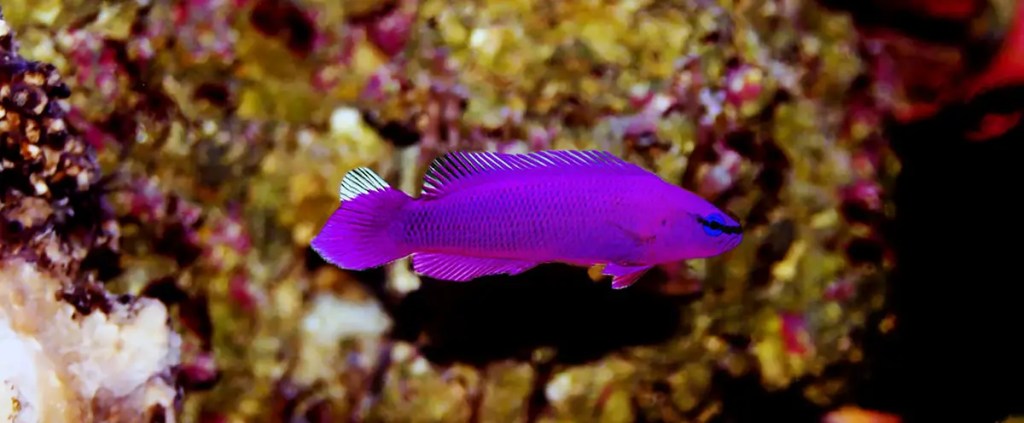
| Family | Pseudochromidae |
| Scientific Name | Pseudochromis |
| Other Names | Strawberry Gramma, Magenta Dottyback |
| Care Level | Easy |
| Temperament | Semi-Aggressive |
| Diet | Carnivorous |
| Water Conditions | 72 to 78-degrees Fahrenheit; pH 8.1-8.4 |
| Type | Saltwater |
| Max Size | 2 Inches |
| Life Span | 5-7 Years |
| Minimum Tank Size | 20 Gallons |
| Compatible With | Semi-aggressive fish, but not other Basslets or Dottybacks |
This single purple saltwater fish is my favorite for keeping as a pet.
The incredibly vivid color makes these guys fun to watch, especially against a dark aquarium background.
They do best in aquariums with plenty of live rock and hiding places and are great community fish when housed with appropriate semi-aggressive species – but not fellow Dottybacks or Basslets.
If, however, you do want multiple Purple Dottybacks, be sure to introduce them to the aquarium all at once to help curb territorial behavior that causes aggression towards each other.
Author note: They're incredibly hardy little fish who need to be kept in aquariums with lids. They're jumpers!
Red Aquarium Fish
#2. Lionfish
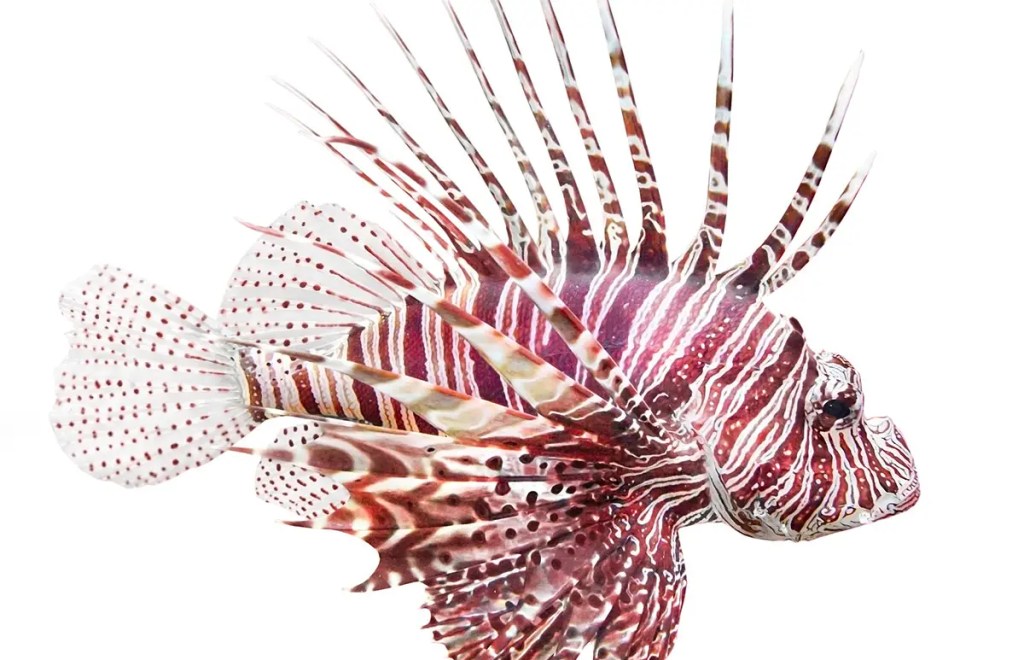
| Family | Pterois |
| Scientific Name | Pteroinae |
| Other Names | Zebrafish, Firefish, Turkeyfish, Tastyfish, Butterfly-cod |
| Care Level | Easy to moderate (species specific) |
| Temperament | Aggressive |
| Diet | Carnivorous |
| Water Conditions | 72 to 78-degrees Fahrenheit; 8.1-8.4 pH |
| Type | Saltwater |
| Max Size | 18 Inches |
| Life Span | Varies by species |
| Minimum Tank Size | 50+ Gallons |
| Compatible With | Similar or larger fish – will eat smaller fish |
Lionfish are native to Indo-Pacific, South Pacific, Sea of Japan, and the Red Sea. However, they have migrated to other parts of the world – including Florida – where they are often considered invasive species.
They prefer the dim light of pre-dawn and evening hours for hunting – i.e. feeding times, people! – which happens to be when they blend in best with their native environments.
Lionfish are mostly solitary and not very active.
They're generally pretty docile towards humans – in fact, I've not seen any real reports of aggression towards humans – but they will swiftly kill a smaller fish in a single motion.
Author Note: It's important to note that the spines on lionfish are venomous. Be careful to always wear thick gloves when the possibility of physical contact with your lionfish may occur.
#3. Flowerhorn Cichlid
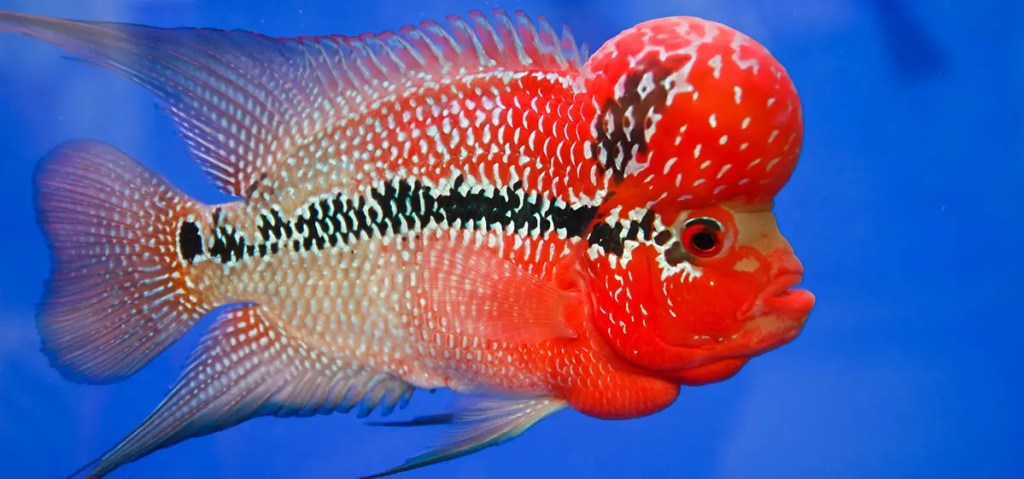
| Family | Cichlid |
| Scientific Name | NA |
| Other Names | Flowerhorn, Hua Lao Han Cichlid |
| Care Level | Easy |
| Temperament | Intelligent, extremely aggressive |
| Diet | Carnivorous |
| Water Conditions | 77 to 84-degrees Fahrenheit; pH 6.0-7.5 |
| Type | Freshwater |
| Max Size | 10 Inches |
| Life Span | 8-10 Years |
| Minimum Tank Size | 100 Gallons |
| Compatible With | None |
Flowerhorn Cichlids are man-made hybrids that originated in Asia and are some of the most colorful cichlids.
They're a stunning and unique freshwater aquarium fish that is easy to care for because, well, they just don't need much.
The one thing he needs constantly, though, is food. It's important to make sure you keep this guy fed at all times.
Otherwise – if you couldn't tell from his diet – he may start eating things he shouldn't.
Top tip: He should never be housed with other fish, as he's extremely aggressive and likely to attack the other creatures, including potential mates.
Keepers should be cautious as well, when coming in contact with them, as they may attack humans if seen as a threat.
But seriously, if you've ever seen these swimming around, you'll know these are some of the coolest freshwater fish to own.
#4. Harlequin Rasbora
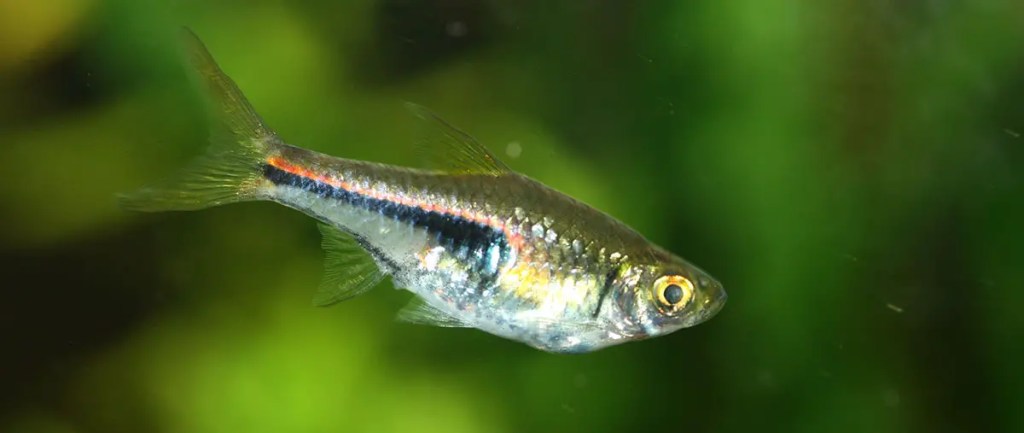
| Family | Cyprinidae |
| Scientific Name | Trigonostigma heteromorpha |
| Other Names | Red Rasbora, Harlequin Fish, Harlequin |
| Care Level | Easy |
| Temperament | Peaceful |
| Diet | Omnivorous |
| Water Conditions | 75 to 81-degrees Fahrenheit; pH 6.5-7.5 |
| Type | Freshwater |
| Max Size | 2 Inches |
| Life Span | 3-4 Years |
| Minimum Tank Size | 5 Gallons |
| Compatible With | Most fish of similar size and peaceful temperaments |
Your Harlequin Rasbora should be kept in schools of at least eight of their own kind. They're schooling fish who tend to get nervous in smaller groups.
Line your tank with dark substrate for peak coloration, and provide your rasboras with live plants, large rocks, and driftwood to imitate their natural habitat.
Make sure your rasbora get a varied diet of high-quality flakes or granules and some small live foods like artemia and daphnia.
They also could use with supplemental dietary items like freeze-fried bloodworms and tubifex worms and even some fresh veggies.
These bright freshwater fish come in a range of colors from pale pink to bright red or coppery orange.
colorful fish: Blue Aquarium Fish
#5. French Angelfish
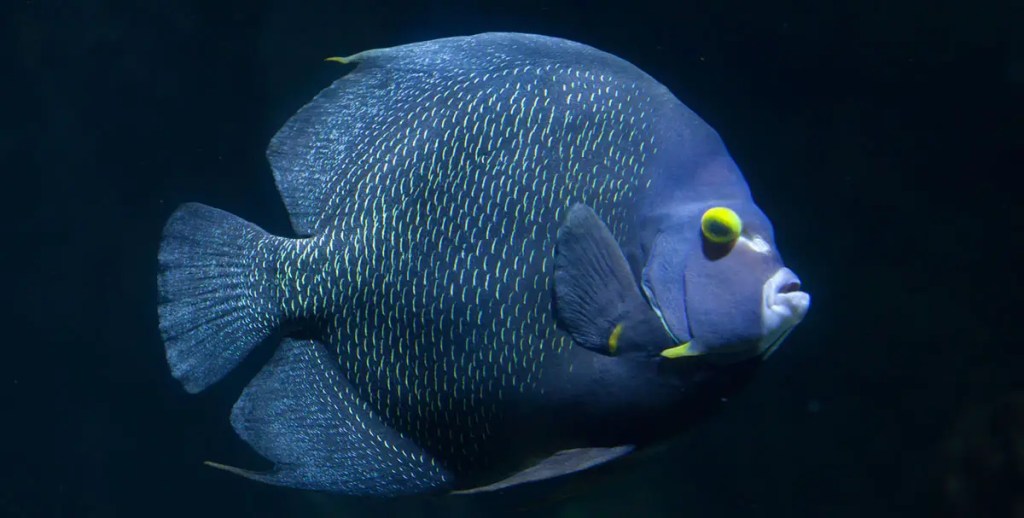
| Family | Pomacanthidae |
| Scientific Name | Pomacanthus paru |
| Other Names | Black Angelfish, French Angel |
| Care Level | Moderate |
| Temperament | Semi-Aggressive |
| Diet | Omnivorous |
| Water Conditions | 72 to 78-degrees Fahrenheit; pH 8.1-8.4 |
| Type | Saltwater |
| Max Size | 15 Inches |
| Life Span | 10-15 Years |
| Minimum Tank Size | 250 Gallons |
| Compatible With | Varied, multiple |
French Angelfish are a fairly hardy species of fish that can live a long time if properly care for.
They're semi-aggressive and should be kept in large aquariums with lots of live rock, sponges, algae, and decorations that help it stay happier and healthier.
They're likely to become the dominant fish in your tank, but they do mate for life if they choose a mate. Generally, speaking, though, they should be kept separate from other French Angels to keep them safe.
Author note: These pretty fish are saltwater fish but are not good candidates for reef tanks since they nip at corals and other sessile invertebrates.
#6. Regal Tang
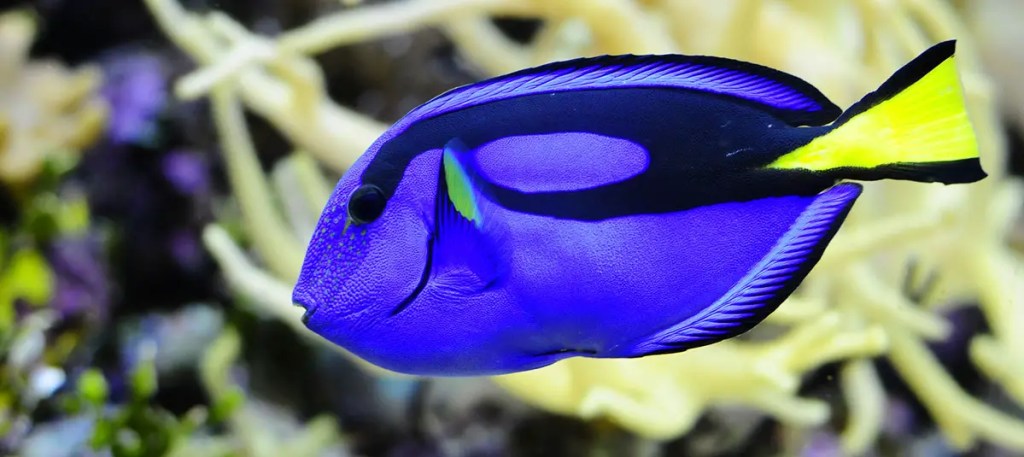
| Family | Paracanthurus |
| Scientific Name | Paracanthurus Hepatus |
| Other Names | Blue Tang, Pacific Blue Tang, Royal Blue Tang, Hippo Tang, Palette Surgeonfish |
| Care Level | Moderate |
| Temperament | Non-aggressive; semi-aggressive toward other Tangs |
| Diet | Naturally herbivorous |
| Water Conditions | 72 to 82-degrees Fahrenheit |
| Type | Saltwater |
| Max Size | 12 Inches |
| Life Span | 20 Years |
| Minimum Tank Size | 100 Gallons |
| Compatible With | Most species, except other tangs |
Royal Tangs are not typically aggressive, except with each other.
If you have a very large tank you can keep more than two together, as they'll have enough space, but generally speaking, Blue Tangs should be kept with other species but not each other.
In other words, they make for great community tank fish.
Since their vibrant blue and yellow coloring makes them some of the most beautiful saltwater aquarium fish, you'll enjoy these little "Dory" fish into your saltwater or reef aquariums.
It's important to note that Regal Tangs need lots of swimming space. They're also warm water lovers and herbivores, meaning they'll eat up that algae that the warmth of the water draws.
Health note: Tangs tend to be susceptible to lateral line erosion and marine parasites, so you'll need to carefully choose and observe your tangs for these potential illnesses.
colorful fish: Multicolored or Varied Color Fish
#7. Betta
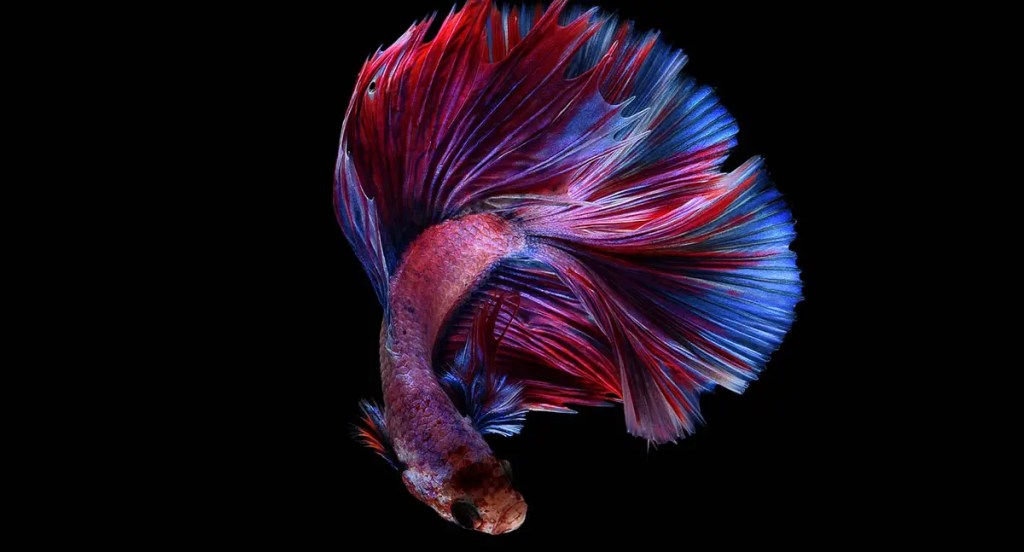
| Family | Osphronemidae/gourami |
| Scientific Name | Betta |
| Other Names | Siamese Fighting Fish |
| Care Level | Easy |
| Temperament | Aggressive |
| Diet | Carnivorous |
| Water Conditions | 76 to 81-degrees Fahrenheit; 6.5-7.5 pH |
| Type | Freshwater |
| Max Size | 3 Inches |
| Life Span | 3-7 Years |
| Minimum Tank Size | 3 Gallons |
| Compatible With | Peaceful non-fin nippers |
Betta are some of the most colorful freshwater aquarium fish, coming in beautiful red, blue, orange, yellow, green and purple freshwater fish.
These stunning creatures are highly aggressive, though, so should always be kept separate from other bettas.
The males should also be kept in tanks that are distanced reasonably far apart to avoid jumping into other tanks for fighting. Females may be kept together if you keep at least five of them together.
And despite common aesthetic practices, betta should never be kept in a bowl. They need a bit of space to move and they always need a lid. These guys are jumpers!
Just make sure the betta can reach the top of the tank, so you may want to opt for a shallow, long aquarium.
Check out our Betta care guide here.
#8. Banggai Cardinalfish
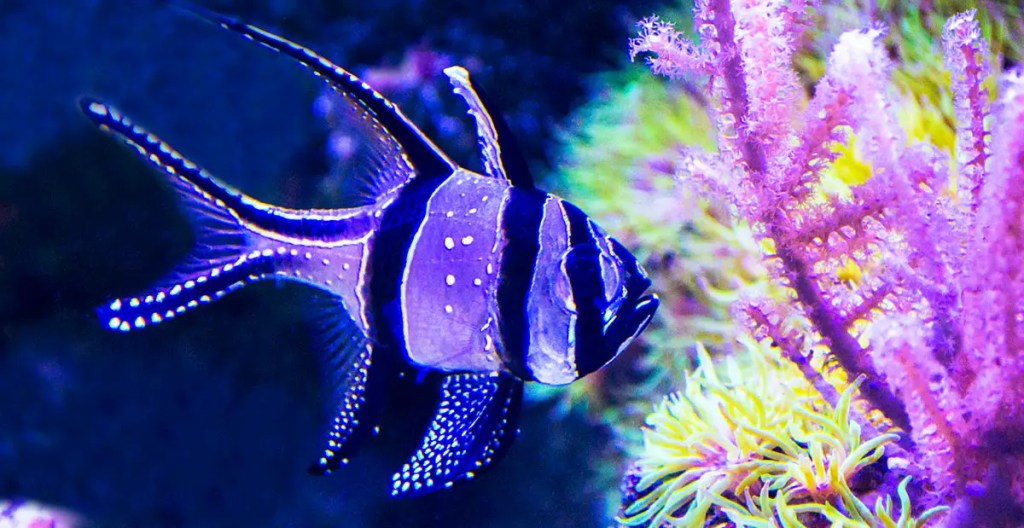
| Family | Apogonidae |
| Scientific Name | Pterapogon kauderni |
| Other Names | Kaudern's Cardinalfish, Longfin Cardinalfish |
| Care Level | Easy to Moderate |
| Temperament | Non-Aggressive |
| Diet | Carnivorous |
| Water Conditions | 75 to 82-degrees Fahrenheit; 8.1 – 8.4 pH |
| Type | Saltwater |
| Max Size | 3 Inches |
| Life Span | 5+ years |
| Minimum Tank Size | 30+ Gallons |
| Compatible With | Peaceful tankmates and mated pairs, schools in large aquariums may be possible |
Banggai Cardinalfish are a peaceful species of reef fish that love the nighttime. They typically hide among coral and anemones during the daytime, so it's recommended that you give them plenty of places to hide.
If you really want to be able to enjoy them during daylight hours.
However, they can become used to being out and about during these hours with some regular encouragement and interaction – that is feeding favorite foods (like treats) during daylight hours.
Larger groups of these cool looking fishes can sometimes split into units and live in different parts of an appropriately sized aquarium.
Large groups in small aquariums, however, will have fights between them, so it's always recommended you strictly follow the guidelines on size tanks for these sparky little fish.
Banggai Cardinalfish thrive in large, spacious reefs with loads of overhangs and nooks.
They need brisk water movement and solid filtration to stay healthy and happy and prefer subdued lighting, especially if you prefer to watch these guys during daytime hours.
These fish are particularly great for nano reef aquariums, but the preferred groupings of eight or more require something like 100+ gallons or a pair should be kept in 30+ gallons.
This helps to prevent them from fighting over territory.
#9. Killifish
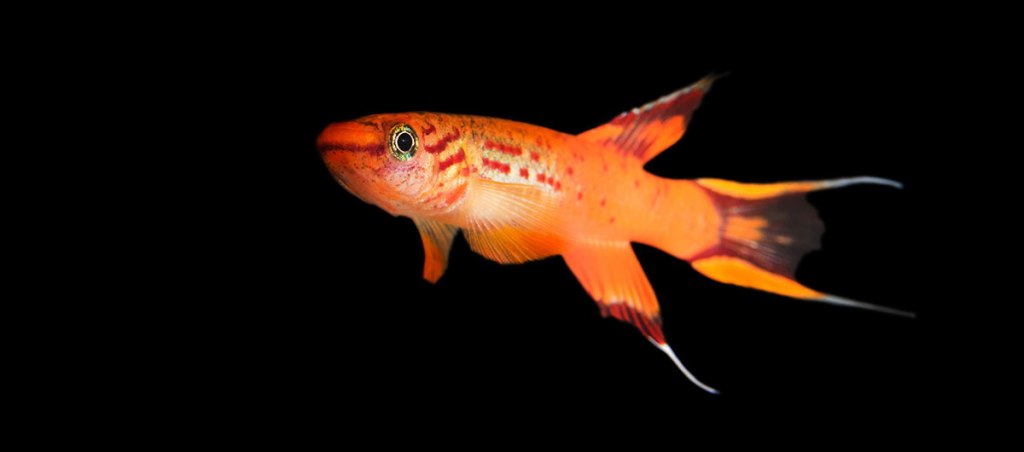
| Family | Aplocheilidae, Cyprinodontidae, Fundulidae, Profundulidae, Valenciidae |
| Scientific Name | Heterandria formosa |
| Other Names | NA |
| Care Level | Easy to Difficult (species dependent) |
| Temperament | Peaceful |
| Diet | Carnivorous |
| Water Conditions | 72 to 75-degrees Fahrenheit; pH 5.5 to 7 |
| Type | Freshwater |
| Max Size | 3.5 Inches |
| Life Span | 3 months to 5 years |
| Minimum Tank Size | 20 Gallons per pair |
| Compatible With | Community tank (species dependent) |
The species of Killifish you choose will greatly impact the lighting conditions your tank needs. Be sure to research this carefully, as some fish prefer anything from shade all the way to direct sunlight. Others prefer very low light.
Most Killifish require low to zero water movement, so many of the accessories that you might to have for other fish won't work well with these little guys.
They do, however still need filters, so it's recommended you use under gravel filters, if possible, to reduce water movement.
These cute freshwater fish are a colorful freshwater community fish that typically come in:
- Red
- Blue
- Green
- Gold
- Orange
- Brown
- Silver
#10. Discus
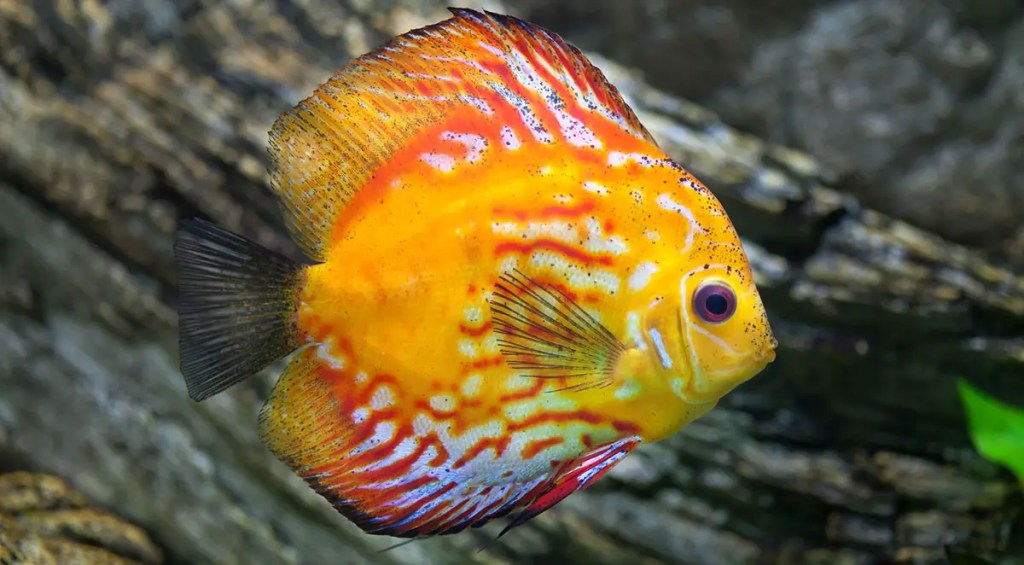
| Family | Cichlid |
| Scientific Name | Symphysodon |
| Other Names | Pompadour fish |
| Care Level | Moderate |
| Temperament | Peaceful |
| Diet | Carnivorous |
| Water Conditions | 82 to 88-degrees Fahrenheit; 6-7 pH |
| Type | Freshwater |
| Max Size | 8 Inches |
| Life Span | 10 years |
| Minimum Tank Size | 50+ Gallons |
| Compatible With | Non-aggressive species |
Discus are beautiful and very peaceful species of fish, and some of the most colorful freshwater fish you can safely keep in an aquarium environment.
They are very sensitive to a new environment, however, so when you bring some home, you'll need to quarantine them for 1-2 weeks before bringing them into the main aquarium.
If possible, treat the quarantine tank with Prazipo when you introduce the discus there.
Discus naturally live in slow-moving tributaries and pools of the forest with dense tree roots, rocks, and thick vegetation. They tend to be shy, so having some of these in their home aquarium will help them feel more at ease.
They need subdued lighting and dark substrate for ultimate happiness and should be kept with other fish that are non-aggressive.
Discus fish come in green, brown, blue, and red colors.
#11. Mandarinfish
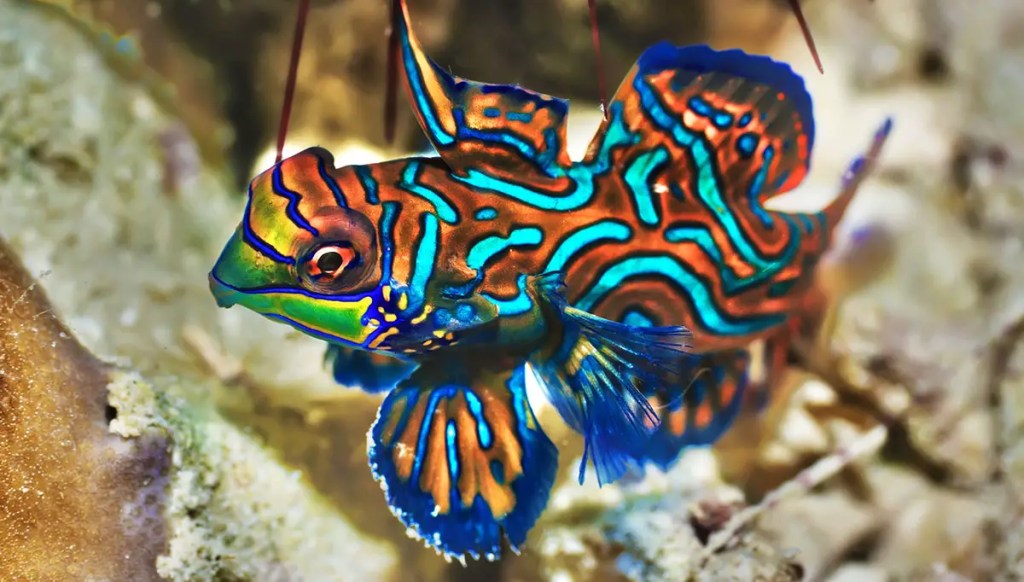
| Family | Synchiropus |
| Scientific Name | Synchiropus Splendidus |
| Other Names | Mandarin dragonet |
| Care Level | Challenging |
| Temperament | Generally non-aggressive |
| Diet | Carnivorous |
| Water Conditions | 72 to 82-degrees Fahrenheit |
| Type | Saltwater |
| Max Size | 4 Inches |
| Life Span | 2-4 years |
| Minimum Tank Size | 30 Gallons per fish |
| Compatible With | Most species, except non-dwarf Angelfish |
Just looking at these stunning fish tells you why these are some of the coolest saltwater aquarium fish ever, despite being a bit challenging to keep safe and healthy.
Mandarinfish in the wild typically eat fish eggs, snails, copepods, and small worms.
However, these are hard to come by for many folks, so you'll want to focus on live food such as brine black worms and other small worms, and, if lucky, you may be able to introduce frozen food varieties like brine shrimp.
Mandarinfish do well in aquariums with lots of live rocks and live sands, as they eat the organisms that grow there.
Keeping Mandarinfish alive can be a challenge in a closed environment like an aquarium.
They need to be trained to consume high-quality, high-protein foods since generally they eat away the copepods on the live rocks and sand reasonably quickly.
This weaning is done through an eyedropper, which many folks have noticed these most beautiful aquarium fish will wait for and suck out the shrimp out of.
Some aquarists have had some success in weaning them onto pellet food.
Mandarinfish are not able to compete with voracious eaters, so you need to be careful not to keep them with aggressive feeders.
Typically, Mandarinfish are blue or green with vibrant orange markings. Sometimes, the orange or red coloring is more dominant, specifically in the species referred to as the Red Mandarinfish.
colorful fish: Yellow and Orange Freshwater and Saltwater Fish for Your Aquarium
#12. Figure 8 Puffer Fish
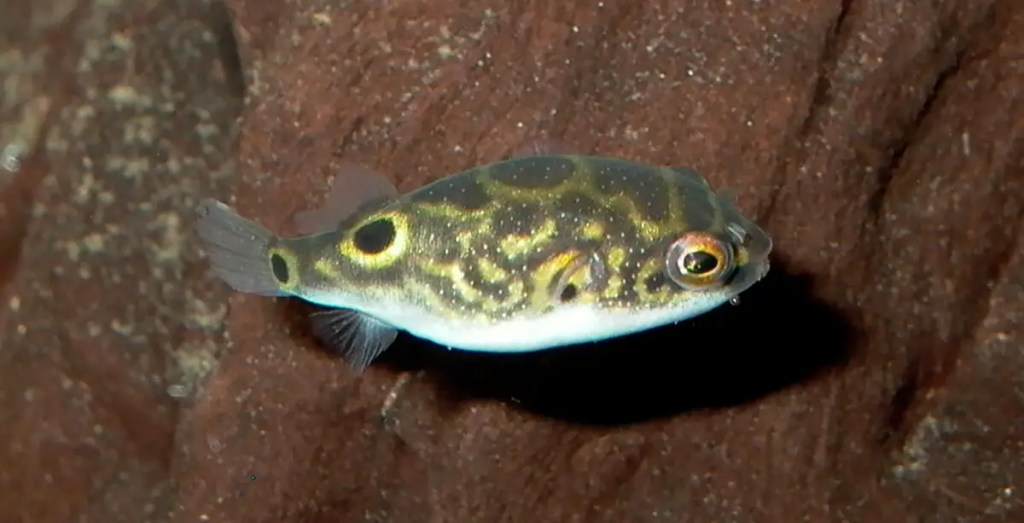
| Family | Tetraodontidae |
| Scientific Name | Tetraodon biocellatus |
| Other Names | Figure eight puffer, Eyespot pufferfish, F8 puffer |
| Care Level | Moderate |
| Temperament | Semi-aggressive fin nipper |
| Diet | Carnivorous |
| Water Conditions | 75 to 82-degrees Fahrenheit; 7.6-8.3 pH |
| Type | Freshwater / Brackish |
| Max Size | 3 Inches |
| Life Span | 15 years |
| Minimum Tank Size | 15 Gallons |
| Compatible With | Limited compatibility with other species and other puffers |
Figure 8 Pufferfish are one of the most colorful varieties of puffers.
Their stunning colors and unique personalities make them an interesting aquarium fish, but they don't generally get along well with others – either puffers or other species of fish.
Figure 8 Puffers are extremely sensitive to toxins in their water, so their environment must be carefully monitored to keep them healthy, thanks to their lack of scales and gill covers.
They do best in low-end brackish water rather than straight up freshwater, but well-cared for Figure 8s have actually been reported to live as long as 18 years.
Since most brackish water fish are sold in freshwater, it's best to make sure you use a fish-less cycling technique to prepare the tank at home.
And once your fish is comfortably adjusted into your home aquarium, they do best with a 50-percent weekly water change for ultimate health and happiness.
These fish are generally found in slowly moving or standing water in Asia and range from a yellow to green coloring.
#13. Clownfish
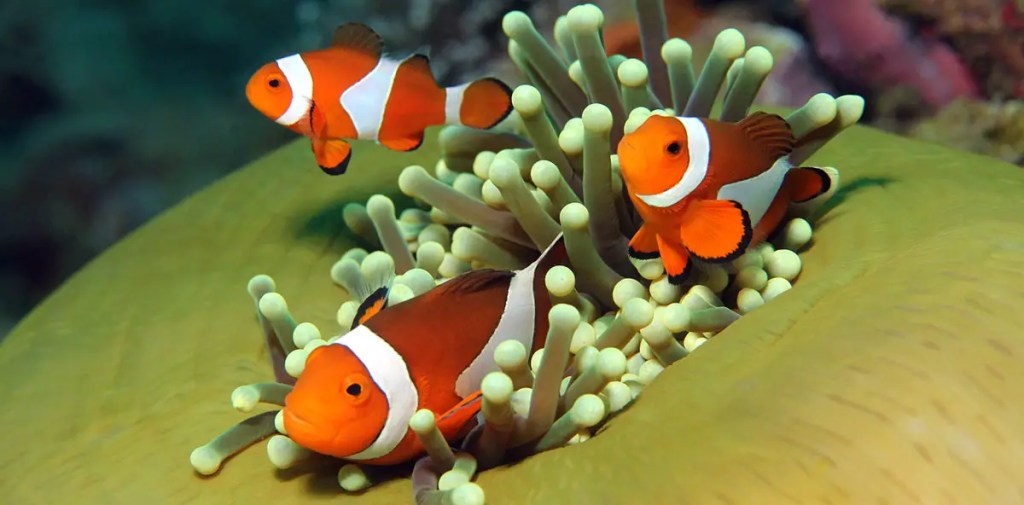
| Family | Pomacentridae |
| Scientific Name | Amphiprion ocellaris |
| Other Names | Anemonefish |
| Care Level | Easy |
| Temperament | Peaceful, but spunky |
| Diet | Omnivorous |
| Water Conditions | 74 to 78-degrees Fahrenheit; 8.0-8.4 pH |
| Type | Saltwater |
| Max Size | 6 Inches |
| Life Span | 3-5 years |
| Minimum Tank Size | 20 Gallons |
| Compatible With | Wide range of compatible tankmates |
Clownfish can live alone or in groups with other clownfish. They're a unique blend of loner and life of the party, with fairly easy-to-care-for needs, as long as their environment has everything they need.
Because of this chill attitude, they do well with other fish, especially more timid and non-aggressive fish.
They do require daily feeding to stay healthy.
While the name of these energetic little fish tell us they have that beautiful symbiotic relationship with anemones, they don't actually require a host anemone to survive.
However, they do best with one, so be sure to research and discover which species of anemones work with the species of clownfish you bring home.
However, novice saltwater aquarists should probably put off getting clownfish until they have a bit more experience in maintaining the right environment, for the sake of those finicky anemones.
WhileFinding Nemo tells us that Clownfish are orange, they actually range from yellow to orange, reddish or even brownish in color.
Bonus: Prettiest Crabs to Keep at Home
#14. Halloween Moon Crab
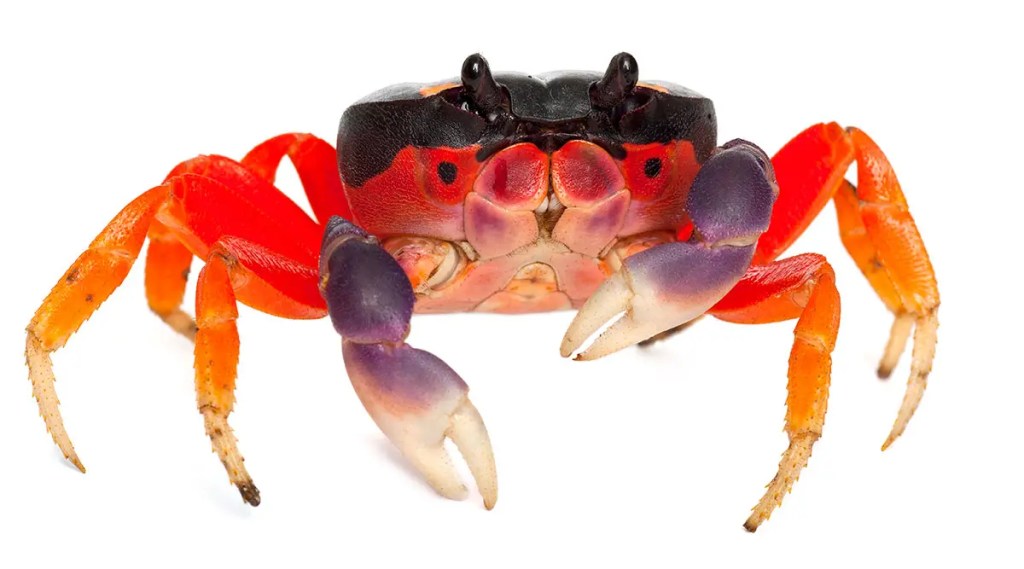
| Family | Gecarcinidae |
| Scientific Name | Gecarcinus quadratus |
| Other Names | Red land crab, white spot crab, Halloween crab, moon crab, mouthless crab, Harlequin land crab |
| Care Level | Moderate |
| Temperament | Varied |
| Diet | Omnivorous |
| Air Temperature | Between 80 and 85-degrees Fahrenheit |
| Type | Land/Saltwater |
| Life Span | 10-12 years |
| Minimum Tank Size | 20+ Gallons |
| Compatible With | Happiest in pairs (one of each gender) |
Halloween Moon Crabs are a quirky, colorful little crab that makes for a good pet, as long as it is well-cared for.
For the best possible life, they should be kept in opposite gender pairs and should be handled daily to help them feel safe and comfortable with human interaction.
Despite what many of the reviews and blogs say on the subject, these guys need aquariums of at least 20-gallons.
They're best housed in aquariums of 50-gallons, though, to allow for roaming, burrowing, and hiding, as they naturally do in their wild habitat.
They also need both land and saltwater areas in their habitats to stay healthy and happy.
Other Popular Colorful Fish
Some of the other most commonly kept, bright, colorful aquarium fish include:
- Fantail Guppy
- Dwarf Gouramis and Blue Gouramis
- Zebra Danios
- Neon Tetras
- Endler's Livebearers
- Platy
- Swordtail
- Goldfish
- Kuhli Loach
- Cherry Barb
- Boseman's Rainbowfish
- Peacock Cichlids
- German Blue Rams
- African Cichlids
FAQs on Colorful Aquarium Fish
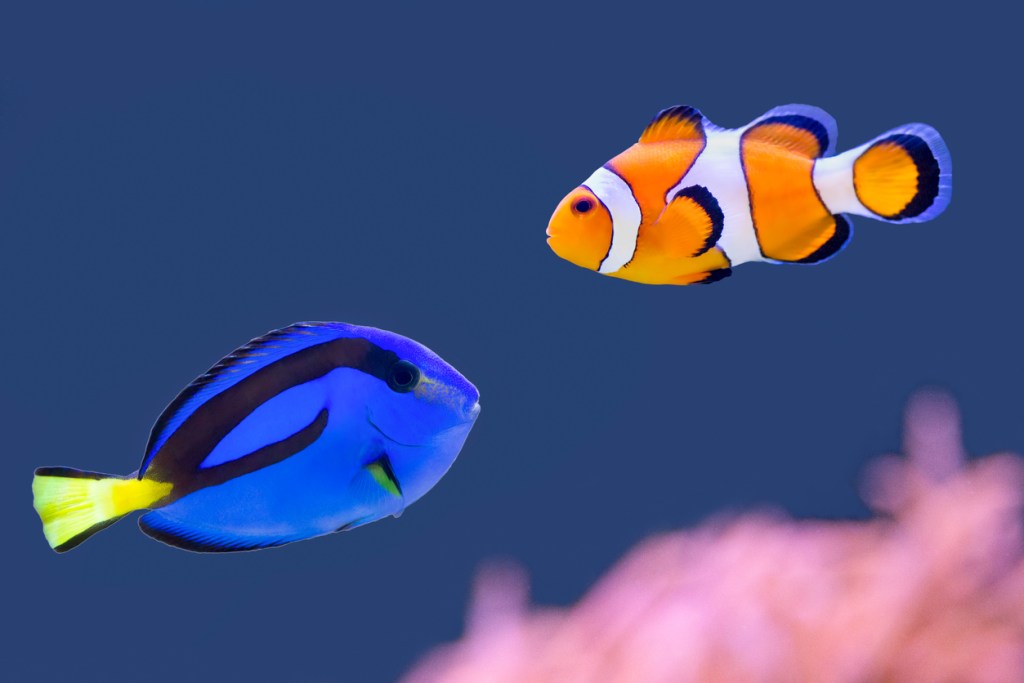
Should you be concerned about your fish's color?
With all the effort you go to to take care of your fish, you need to take the time to make sure your fish are healthy.
The best way to enjoy your fish's color and the effect it has on your aquarium is by making sure they are as colorful as they can be.
There are several reasons why your fish's color may fade. Some of the fade may be just due to age. However, it is possible your fish's color has been affected by its diet and environment.
While it is possible to manipulate your tank's lighting in order to enhance the fish it is better to make sure there are no environmental or illness causing your fish to lose color.
Is it possible to enhance the color of your fish?
There are some natural ways to enhance the color of your fish. All of these are to do with your fish's living conditions.
A significant reason fish may lose their colors is high amounts of stress. The more pressure a fish feels, the more likely it will start to become sick.
This can come from disruptive environments or even other fish bullying them. Make your fish's environment safer, and they will be happier and full of color.
Giving your fish premium quality food is a sure-fire way to make them happier, healthier, and more colorful.
For example, for fish that eat algae, it's known that spirulina can help enhance a fish's color. This type of algae can be fed in either pellets or flakes.
Source: https://www.vivofish.com/most-beautiful-colorful-aquarium-fish/
0 Response to "Types of Beutiful Fish That Are Easy to Color"
Post a Comment